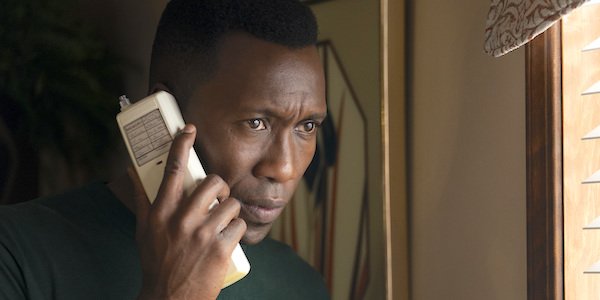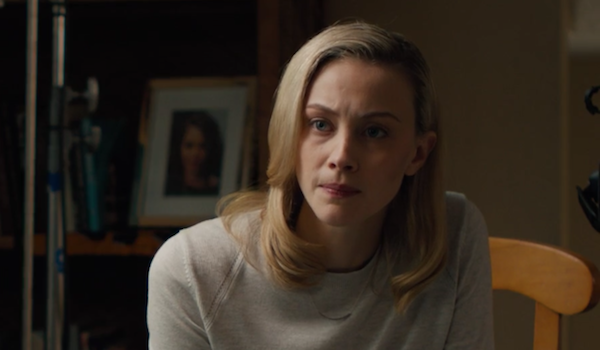True Detective Season 3 Made A Huge Season 1 Connection, But What Does It Mean?

Major spoilers below for anyone who isn't fully caught up with True Detective's grim third season.
In the penultimate installment of Wayne and the Terrible, Horrible, No Good, Very Grim 35-Year Time Span, Will Purcell's death and Julie Purcell's disappearance made their full tin-foil-hat descents into conspiratorial waters. In making that happen, "The Final Country" not only cemented that True Detective's mysteries are taking place within the same TV universe, but a case was made that Arkansas' dark underworld may be directly connected to Rust and Marty's investigations. Let's discuss.
The Connection
Sarah Gadon's levity-free docu-producer Elisa has served as a mostly annoying (if arguably necessary) audience surrogate throughout the 2015 timeline. But while viewers are mostly interested in discovering the truth for themselves, Elisa has had a slightly evolved agenda throughout her conversations with Wayne.
Elisa does seem genuinely curious to know what actually happened to Will and Julie Purcell, but she is also highly keen on turning the cold cases into a prism through which everyone can see various levels of corruption tied to law enforcement and small-town businesses empires. Elisa didn't have a metaphorical smoking gun for her last-minute overture, but rather a pair of chain-smoking detectives.
For her biggest theory – which amusingly felt no less paranoid than Wayne peering through his blinds at mysterious sedans – Elise pulled up the local newspaper story reporting on Rust Cohle and Marty Hart successfully catching serial killer Errol Childress, the spaghetti monster creep behind some of Season 1's most heinous crimes. (Note that this was the first verbal reference to the case/article, though the newspaper image was noticed by eagle-eyed viewers in an earlier ep.)
Elisa's heavy implications reminded everyone that the further nightmarish scenarios surrounding those murders went unchecked on a grand scale, because #GovernmentCoverUp. She tries to angle her questions to Wayne around the concept of collusion, but it seems obvious that whatever happened in that car ride with Hoyt permanently changed Wayne's life and his ties to the case.
Elisa's finger-pointing detective work seems to come out of left field only because the more recent episodes within True Detective's third season wisely stepped back from constantly reminding viewers of yellow kings and cryptic keepsakes. It's an interesting and important connective to make, even if there aren't any legitimate parallels to draw between Season 1's Reverend Billy Lee Tuttle and Season 3's chicken tycoon Hoyt, who will be played by Walking Dead vet Michael Rooker in the season finale.
Your Daily Blend of Entertainment News

What It Could Mean
As far as Elisa is concerned, the most ideal conclusion here would likely involve the discovery that the game-hunting billionaire Hoyt is directly related to Billy Lee Tuttle and Errol Childress. Bloodlines obviously don't amount to a court-accepted proof of guilt, but that'd be more circumstantial than some of the dead ends that have plagued Wayne and Roland's efforts.
If such connections can be made, then it would presumably create bizarre and interesting in-universe ramifications for the Season 3 characters and the Season 1 folks. First, if Julie's Pink Room was discovered to be another one of Reverend Tuttle's victim pools for trafficking and/or molestation purposes, then it would likely demand new investigations surrounding Rust and Marty's cases around the time the initial crimes took place.
Viewers shouldn't hold their breath for any high-profile cameos from Matthew McConaughey or Woody Harrelson, but their presence wouldn't be required to make the reopened cases interesting. It's not often that vast state-jumping conspiracies like this are uncovered in the real world, so it would be very intriguing to see True Detective reveal itself as a fully interconnected TV universe. (Even if most of the events of Season 2 fell by the wayside.)
The guilty pleasure center of my brain would explode if Hoyt pulled off a Scooby-Doo moment where he rips off his Michael Rooker mask to reveal that he's actually been Jay O. Sanders' Reverend this entire time. And he might have gotten away with it, too, if it wasn't for those machismo-guided detectives and their talking dog. (Well, minus the talking dog bit.)

What It Probably Does Mean, Though
Because we know how modern hype-focused TV works, it's honestly hard to believe that True Detective creator and head writer Nic Pizzolatto actually will dive off the deep end to connect Season 1's pedophile ring with whatever the hell is happening in Season 3. Pizzolatto doesn't really seem like the kind of creator who obsesses over geeked-out fan servicing.
It's perfectly fine that Elisa makes the reveal that Wayne Hays and Roland West live a few hours from where Rust Cohle and Marty Hart became local celebs for their long-term efforts. However, I can only assume that connection is just generally pointing to how utterly vile and reprehensible people can become when money, power and lust guide their actions. The point likely isn't to incite fan demands for crossovers, but rather to point out just how corrupt and fucked up "the system" is on all tiers.
After all, if True Detective did mash the Tuttle and Hoyt cases together under the unforgivable umbrella of child endangerment (to use hyperbolic understatement), Nic Pizzolatto would be setting up the possibility that the evil minds behind all those atrocities could indeed be squashed and brought to justice in some way. Maybe it's just me, but I don't see the HBO drama ever presenting its various crimes as ultimately conquerable.
I feel that in each iteration of True Detective's seasons, the weight of the world is meant to suffocate all, without much exception. To successfully wrap up any of these cases, without leaving any loose ends, is likely antithetical to the way Nic Pizzolatto's mind works when he's putting True Detective's narratives together. Human nature is what it is, for better or worse.
If the whole point of True Detective was to work like a Law & Order or NCIS episode, where all the details are laid out to solve a crime by the episode's end, that'd be one thing. But this is a series more focused on the permanent effects that these dark and demented crimes have on everyone involved. As such, I don't think True Detective's direct nods to Season 1 will be indicative of anything other than people becoming monsters sometime.
Already one of the most intriguing standouts of the 2019 midseason, True Detective is gearing up to close out Season 3's storyline with its season finale, airing on HBO on Sunday, February 24, at 9 p.m. ET.

Nick is a Cajun Country native and an Assistant Managing Editor with a focus on TV and features. His humble origin story with CinemaBlend began all the way back in the pre-streaming era, circa 2009, as a freelancing DVD reviewer and TV recapper. Nick leapfrogged over to the small screen to cover more and more television news and interviews, eventually taking over the section for the current era and covering topics like Yellowstone, The Walking Dead and horror. Born in Louisiana and currently living in Texas — Who Dat Nation over America’s Team all day, all night — Nick spent several years in the hospitality industry, and also worked as a 911 operator. If you ever happened to hear his music or read his comics/short stories, you have his sympathy.
